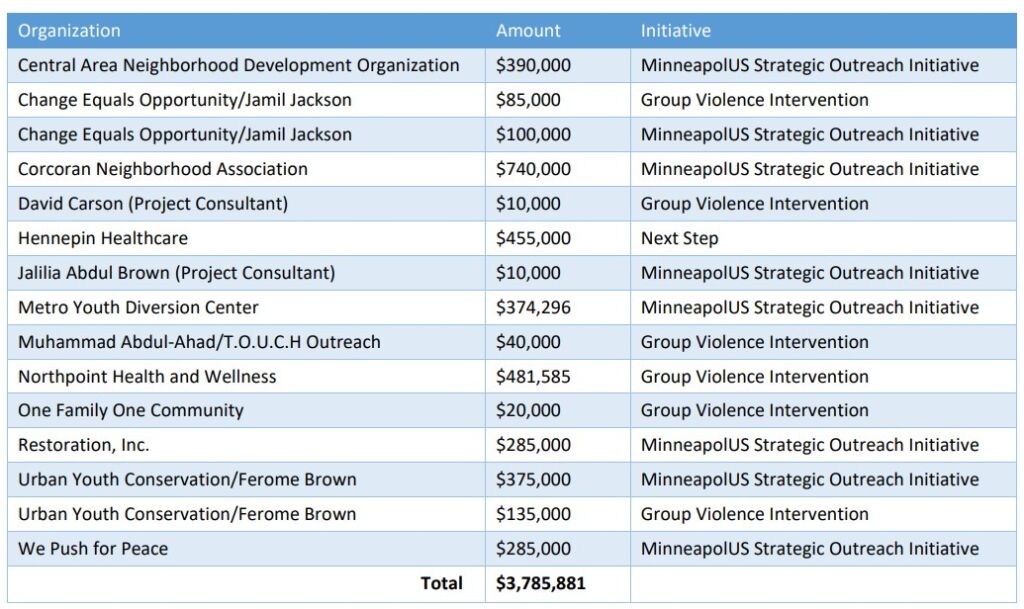Are ‘violence interrupters’ working?
Nobody seems to know. But no worries, much more money will be spent on the effort.
In Minnesota, the City of Minneapolis is at the forefront of the use of “violence interrupters” as a tool to fight violent crime. The idea behind interrupters began with mediating disputes between gangs before they escalated into violence.
As practiced by Minneapolis, the concept has expanded to include an on-street presence in areas of the city plagued by violent crime.
The city’s efforts have been coordinated out of the Office of Violence Prevention. The program began in 2018, and it got a boost with the 2021 launch of its MinneapolUS Strategic Outreach Initiative. Here’s who got funded back in 2021.

Unfortunately, the office hasn’t updated its website since 2021. It’s confusing, but the effort seems now to fall under something called the Department of Neighborhood Safety.
Almost a year ago (February 2022), it was reported that Minneapolis had committed up to $7.5 million to the idea for 2022/2023, doubling the initial amount. Five entities (out of seven) received contract extensions at that time.
It appears that the city has included a further $13 million in its budget for this effort for 2024-2028.
Is it working? A Google search for an answer doesn’t produce anything substantive since spring of last year.
In May 2022, KSTP reported on the city’s Initiative one year in.
Sasha Cotton, director of the Minneapolis Office of Violence Prevention, laid out a progress report on the city’s violence interrupter initiative, which consists of 151 people across seven nonprofit groups that patrol “crime hot spots.”
Two of the seven organizations are profiled in the KSTP piece. One organization doing such work goes by the name Restoration, Inc. The story includes a quote from the organization’s CEO. It was founded as a for-profit company in 2015. As a for-profit entity, its tax returns are not publicly available.
Also included in the KSTP profile is the nonprofit We Push for Peace. The group first incorporated in 2016 and received its tax-exempt status in 2020. The group has never earned more than $50,000 in a year, according to records on file at the IRS.
In two different incidents in 2021, We Push for Peace staffers were involved in violent incidents outside of St. Paul CUB Foods locations. In the earlier incident, a violence interrupter was caught on video beating a homeless man.
None of the other participants in the violence interrupter program appear to have had the resources to provide services at this scale at the time they were selected by the city.
The Central Area Neighborhood Development Organization (a/k/a CANDO) has been around since 2004. Its most recent tax return (for 2019) shows seven employees and total revenue of $343,000, an amount smaller than its 2021 violence interrupter grant of $390,000.
Change Equals Opportunity was incorporated in 2011. It’s run by a high school basketball coach and its contract with the city was recently renewed (last item). We were unable to locate any financial records for the nonprofit.
The Corcoran Neighborhood Organization was incorporated as a nonprofit in 1994, but has been around in some form since 1975. Its most recent tax return (for 2019), shows zero employees and total revenue of $331,000. That dollar amount is less than half of the 2021 interrupter grant.
Metro Youth Diversion Center was incorporated in 2019. Its tax returns for both 2019 and 2020 show annual revenue below $50,000.
Urban Youth Conservation was incorporated in 2012. All of its tax returns from 2015 through 2020 show annual revenue below $50,000.
An earlier round of grants, totaling $350,000, was awarded in 2021. A total of 15 groups received money, ranging from $10,000 up to $43,750.
One of the groups receiving one of the largest grants was Somali Community Resettlement Services. We’ve written about this organization several times, as it features prominently in the free-food programs in Minnesota. Based in southern Minnesota, the group has increased its presence in Minnesota by purchasing a historic mansion in town for $2.6 million.
Also receiving a violence prevention grant of $21,000 was the Hennepin Theater Trust, which operates four theaters on Hennepin Avenue in downtown Minneapolis. A group called, “Art is My Weapon” also received $21,000.
In 2021, Minneapolis saw a slight dip in violent crime (property crime was up). Minneapolis Mayor Jacob Frey mentioned violence interrupters as playing a role.
State Representative Cedrick Fraizer (DFL-New Hope) introduced HF 25 this session. Among other items, the bill would provide $150 million for violence prevention efforts, statewide, which could include violence interrupters.
The bill received a hearing in the House Public Safety Commitee last week. The City of Minneapolis wrote a letter in support of this provision of HF 25. The bill passed the committee.